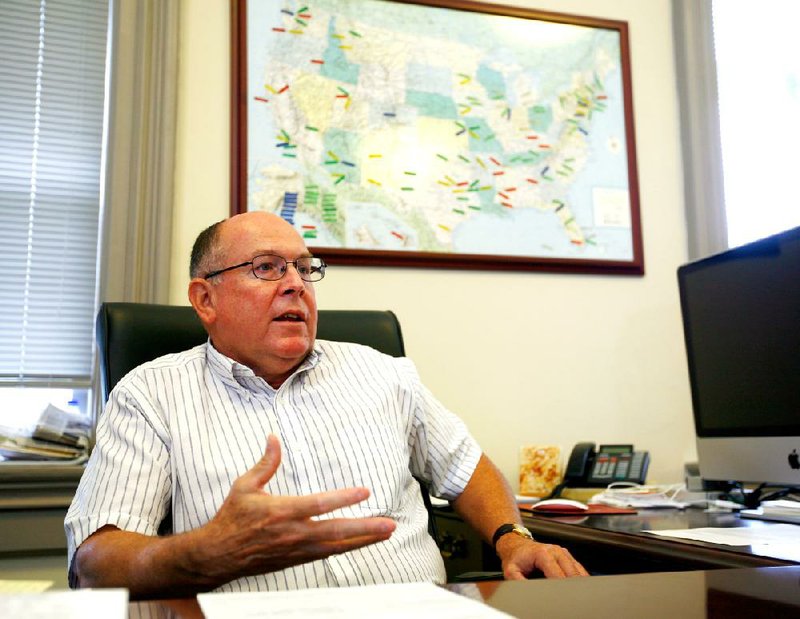FAYETTEVILLE — While the Colorado movie theater massacre does not meet the FBI’s definition of terrorism, the behavior of the suspected gunman leading up to the tragedy was similar to that of a terrorist, a University of Arkansas professor said.
Terrorism usually involves careful planning and preparation, said Brent Smith, a distinguished professor of sociology who directs the Terrorism Research Center at the Fayetteville campus.
James Holmes, charged Monday with 142 criminal counts, including 24 of first degree murder, is accused in the July 20 rampage that left 12 people dead and 58 wounded in Aurora, Colo.
Holmes began buying guns in Denver-area stores nearly two months before the shooting, according to police. He also received at least 50 packages in four months at his home and the University of Colorado-Denver, police said, and he purchased thousands of rounds of ammunition over the Internet.
He also purchased components for incendiary devices he used to booby-trap his apartment, police said.
Smith, author of the 1994 book Terrorism in America: Pipe Bombs and Pipe Dreams, said the best deterrent for such an act of violence “lies in the development of national computerized databases of known terrorist precursor purchases and behaviors.”
Chairman of UA’s department of sociology and criminal justice, Smith has studied domestic terrorism for 20 years.He has testified several times before the U.S. House Judiciary Subcommittee on Crime.
“Preparing for an act of terrorism, whether committed by a ‘lone wolf’ or by a terrorist cell, usually involves a series of preparatory or ‘precursor’ events,” he said. “These behaviors can serve as pre-incident indicators for intelligence analysts and counter terrorism officials.
“In many cases, FBI Joint Terrorism Task Forces ... around the country uncover criminal behaviors unrelated to terrorism as part of the intelligence gathering process,” he said. “It is this arena that holds the greatest promise for early intervention and prevention of acts such as occurred at Aurora.”
All of the purchases may have been legal, Smith said, but their combination coupled with the report that Holmes acted strangely at a Colorado gun range in June could have been pieced together by an intelligence analyst using online purchase and behavior databases, he said.
The databases would be “subject to careful scrutiny relative to civil liberty,” he said.
Rita Sklar, executive director of the American Civil Liberties Union of Arkansas, said she’s discouraged by the recommendation that greater data collection be used as a crime-prevention tool.
“If we’re talking about greater scrutiny about direct purchases of guns, ammunition and bomb materials, that’s one thing,” Sklar said. “But the promoters of these strategies want a database of activities that are otherwise innocuous.
“The bottom line is, yes, if you let the government collect, store and analyze data on everyone, you might prevent a crime,” she said. “But the price is too high. In order to collect information on the bad guys you have to collect information on everyone to find out who the bad guys are. There’s enough of that being done already.”
But Smith said he’s not suggesting a purchase database track everything people buy. An algorithm could be developed that would flag blending of such purchases.
Holmes reportedly “bought a 100-round magazine,” Smith said. “That’s not an everyday purchase a gun owner would make.”
The FBI, which considers acts of terrorism only to be those intended to cause political or social change, already works with the U.S. Department of Homeland Security and private industry on similar databases, Smith said.
One is InfraGard, a partnership devoted to sharing information about threats to U.S. physical and Internet infrastructure.
Another is the Homeland Security Department’s Nationwide Suspicious Activity Reporting Initiative, which established a standard process to identify and report suspicious activity in jurisdictions across the country, according to the department.
And there’s also Homeland Security’s state and major urban area fusion centers, which receive, analyze and share threat-related information between the federal government and state, local and private-sector partners.
If the purchases police say Holmes made in the weeks and months leading up to the shooting were tracked in the online purchase database Smith is recommending, they could have triggered an inquiry, he said.
“Not necessarily a criminal investigation,” he said. “But an inquiry. That means someone would go out and interview him. It may have scared this guy off.”
Smith said the creation of these databases is probably more realistic than attempts to pass stricter gun laws.
The Terrorism Research Center at UA, housed in the J. William Fulbright College of Arts and Sciences, was created in 2003 to facilitate research on terrorism, extremist violence, and the effectiveness of intervention strategies, Smith said.
The center hosts the American Terrorism Study, the nation’s longest-running research project on terrorism in the United States.
Arkansas, Pages 11 on 07/31/2012
